- 1Department of Electrical and Computer Engineering, Boston University, Boston, MA, United States
- 2Division of Material Science and Engineering, Boston University, Brookline, MA, United States
- 3Department of Physics, Boston University, Boston, MA, United States
In this paper, we study the wave transport and localization properties of novel aperiodic structures that manifest the intrinsic complexity of prime number distributions in imaginary quadratic fields. In particular, we address structure-property relationships and wave scattering through the prime elements of the nine imaginary quadratic fields (i.e., of their associated rings of integers) with class number one, which are unique factorization domains (UFDs). Our theoretical analysis combines the rigorous Green’s matrix solution of the multiple scattering problem with the interdisciplinary methods of spatial statistics and graph theory analysis of point patterns to unveil the relevant structural properties that produce wave localization effects. The onset of a Delocalization-Localization Transition (DLT) is demonstrated by a comprehensive study of the spectral properties of the Green’s matrix and the Thouless number as a function of their optical density. Furthermore, we employ Multifractal Detrended Fluctuation Analysis (MDFA) to establish the multifractal scaling of the local density of states in these complex structures and we discover a direct connection between localization, multifractality, and graph connectivity properties. Finally, we use a semi-classical approach to demonstrate and characterize the strong coupling regime of quantum emitters embedded in these novel aperiodic environments. Our study provides access to engineering design rules for the fabrication of novel and more efficient classical and quantum sources as well as photonic devices with enhanced light-matter interaction based on the intrinsic structural complexity of prime numbers in algebraic fields.
1 Introduction
The spatial localization of light in open scattering environments with a refractive index that randomly fluctuates over the wavelength scale has attracted intense research activities in the last decades thanks to its wealth of mesoscopic physical effects with potential applications to advanced photonics technology [1, 2]. Dielectric random media play an important role in a wide range of optical applications such as, for instance, novel light sources and random lasers [3, 4], photonic filters and waveguides [5], lens-less imaging systems [6, 7], broadband sensors and spectroscopic devices [8]. Due to the crucial role played by wave interference effects in the multiple scattering regime, the optics of disordered dielectric structures shows profound analogies with the transport of electrons in metallic alloys and semiconductors [9, 10]. As a result, various mesoscopic phenomena known for the electron wave transport in disordered materials, such as the weak localization of light, universal conductance fluctuations, short/long range speckle correlations, and Anderson localization, have found their counterparts in disordered optical materials as well [2, 9–11]. All these phenomena arise from wave interference contributions in the multiple scattering regime which, in the case of Anderson localization, completely break down the traditional (i.e., perturbative) transport picture and bring light propagation to a complete halt [9, 10]. However, despite a continued research effort, Anderson localization of optical waves remains an evasive phenomenon since it does not occur in open-scattering three-dimensional random media when the vector nature of light is considered [12]. This is credited to the detrimental effects of the evanescent-field coupling of randomly distributed vector dipole scatterers that confine electromagnetic waves at the sub-wavelength (near-field) scale in dense scattering media [13, 14]. In fact, the excitation of sub-radiant (dark) near-field modes, or “proximity resonances”, severely limits the occurrence of the interference loops that drive localization effects in such systems [13, 15]. Moreover, unavoidable structural fluctuations in random media often limit their applicability to optical device engineering [16]. As a result, there is currently a compelling need to create optical media that are structurally complex, yet deterministic, in order to provide alternative routes for localization and strong light-matter coupling effects without the involvement of any statistical randomness.
In order to address this fundamental problem, we have recently introduced a novel approach to wave localization science and technology that leverages the structural complexity of prime numbers in quadratic fields [17–20]. Building on our previous work, in this paper we focus on two-dimensional (2D) arrays of scattering dipoles arranged according to the distributions of prime numbers in imaginary quadratic fields (i.e., in the associated rings of integers) and systematically investigate their structural, scattering, and wave transport properties. For conciseness, we refer to these systems as Complex Prime Arrays (CPAs) [17]. Our primary goal is to provide a comprehensive analysis of the relationship between structural and spectral properties that govern the distinctive optical behavior of the entire class of CPAs with unique factorization properties. In particular, we apply the interdisciplinary methods of spatial statistics [21], spectral graph theory [22], and multifractal scaling analysis [23, 24] to gain information on the geometrical and connectivity properties of the investigated structures that drive their characteristic localization behavior. Using the Green’s matrix method, which has been extensively utilized in the study of the scattering resonances of open aperiodic media [13, 25–31], we investigate the spectral statistics of scattering resonances by means of extensive numerical calculations of large-scale aperiodic arrays that cannot otherwise be accessed via traditional numerical methods such as Finite Difference Time Domain (FDTD) or Finite Elements (FEM). Importantly, the Green’s matrix method allows one to obtain full spectral information and access spatial and temporal localization properties from the frequency positions and lifetimes (i.e., the inverse of the resonance width) of all the scattering resonances supported by the investigated systems. Based on the analysis of spectral statistics, we demonstrate a clear Delocalization-Localization Transition (DLT) characterized by a drop of the Thouless number below unity and a switch of the level spacing from repulsion to clustering with a power-law scaling as a function of the optical density of the system. Finally, we address the Local Density of States (LDOS) and Purcell enhancement in CPAs and demonstrate Rabi splitting of embedded dipole emitters in the strong-coupling regime. Our results show that CPAs are gapped systems with a multifractal spectrum of localized resonances resulting in a far-richer scattering and localization behavior compared to both periodic and uniform random structures. Our comprehensive analysis is meant to stimulate the development of novel compact photonic devices with broadband enhancement of light-matter interactions in both the classical and quantum regimes.
The paper is organized as follows: in section 2, after a concise introduction of the relevant number-theoretic background, we discuss the diffraction and structural properties of CPAs. In section 3 we address the wave transport and localization properties of CPAs through the analysis of the Green’s matrix spectra, level spacing statistics, spectrally-resolved Thouless numbers. In section 4 we investigate the LDOS properties of CPAs and establish their multifractal features by employing the multifractal detrended fluctuations analysis. Section 5 introduces the radiation analysis of CPAs by focusing on Eisenstein prime arrays and demonstrates the Rabi-splitting of embedded quantum emitters in the strong-coupling regime. The last section draws our conclusions.
2 Primes in Imaginary Quadratic Fields: Structural Properties
2.1 Algebraic Number Theory Background
In order to better appreciate our discussion of the structural and optical properties of CPAs, we first introduce the relevant mathematical background and terminology. The idea to generalize the familiar properties of rational numbers to algebraic number fields has a long history in mathematics dating back to the pioneering works of Gauss, Kummer, and Dedekind that initiated Algebraic Number Theory (ANT) [32–34]. Closely related to the theory of representations of integers by binary quadratic forms, quadratic field theory was largely stimulated by the long search for the solution of Fermat’s last theorem, whose complete proof was published by Andrew Wiles in 1995 [35], as well as by Gauss’s seminal work on quadratic reciprocity and cyclotomic fields [33, 36]. The vast subject of ANT rapidly grew into a fascinating area of modern number theory with fundamental connections to many other branches of mathematics [37–41]. The basic notion of ANT that we leverage in our paper is the concept of a quadratic field, which is defined as a degree two extension of the field of rational numbers
By definition, this set of points forms a linear vector space over
In our paper we discuss the optical properties of CPAs obtained from imaginary quadratic fields. Since we will be studying arrays of prime numbers and their distinctive aperiodic distributions, the primes are considered in the rings of quadratic integers associated to quadratic fields. We remind that rings are fundamental algebraic structures consisting of sets of elements equipped with two binary operations that are connected by a distributive law and satisfy properties entirely analogous to those of the familiar addition and multiplication of integers. Therefore, algebraic rings allow one to extend basic arithmetic concepts, such as divisibility or prime factorization, to more general settings [42]. A central result of number theory [39] provides a convenient characterization for the integer ring
An important example of a ring of algebraic integers is the one of the Gaussian integers, i.e.,
where
The reciprocity law can also be extended to higher-order congruences, leading for example to the cubic reciprocity law that was originally proven by introducing the algebraic ring
This is the ring of Eisenstein integers, which are arranged geometrically in a triangular lattice in the complex plane. Eisenstein integers have the 6 units ± 1,
In order to introduce and characterize the CPAs investigated in this paper we must review some basic facts on the factorization problem in quadratic rings. We say that an element of a quadratic ring of integers α is irreducible if it cannot be factorized into the product of two non-units. On the other hand, a non-unit element p of a ring is called a prime if, whenever p divides the product βγ of two elements of the ring, it also divides either β or γ. We remark that the irreducible elements should not be confused with the prime elements. In fact, a prime in a general ring must be irreducible, but an irreducible is not necessarily a prime. The two concepts coincide only for the special rings that admit a unique factorization. Moreover, the rings that admits a Euclidean algorithm for the greatest common divisor of two elements with respect to their norm are called Euclidean domains (or norm-Euclidean). The concepts reviewed here allow one to naturally generalize many known arithmetical facts from rational integers to algebraic rings. In particular, Gauss was able to prove that unique prime factorization also occurs in the Gaussian and Eisenstein integers [33]. However, rings associated to quadratic fields
2.2 Generation and Structure of Complex Prime Arrays
The scattering arrays that we study in this paper correspond to the primes and irreducible elements in the nine imaginary quadratic rings that are also UFDs. To generate these CPAs, we rely on the fundamental classifications of primes based on the norm and the discriminant of the field [43, 44]. The discriminantδ of the imaginary quadratic field
The prime numbers in the ring of integers
• If N(α) is a rational prime, then α is a prime,
• An odd rational prime p is a prime in
• 2 is prime in
where the Legendre symbol
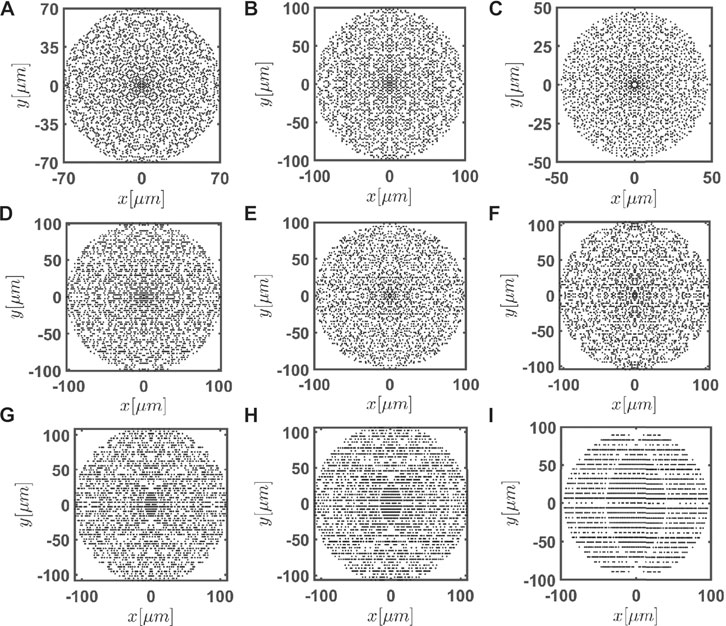
FIGURE 1. Panels (A–I) show the point patterns generated by the prime numbers in the complex quadratic fields
Returning to the distributions of complex prime arrays, the asymptotic density is known to be larger for the Eisenstein and Gaussian primes compared to the primes in all the other quadratic fields [44]. We observe that this asymptotic property is also satisfied by the finite-size CPAs that we considered in Figure 1, indicating that the analyzed structures are sufficiently large to manifest the distinctive prime behavior. In particular, the values of prime densities estimated the analyzed CPAs are
where the case d = −2 has the smallest density and the Eisenstein primes (d = −3) has the largest one given a maximum norm R. As it will appear later in this paper, the high degree of rotational symmetry (6-fold) combined with the larger density of the Eisenstein primes makes this CPA platform particularly attractive for the engineering of photonic sources and quantum emitters with high quality factors.
In panels (f-i) of Figure 1 we show the CPAs that correspond to the non Euclidean imaginary quadratic fields (d = −19, −43, −67, −163). Differently from the case of the Euclidean structures discussed above, it is evident that all the non Euclidean CPAs share a remarkable structural similarity. In particular, we observe two opposing elliptical shaped patterns of prime gaps resulting from the presence of linear sequences of primes arranged along consecutive horizontal lines. Interestingly, the presence of characteristic linear substructures of primes in the non Euclidean CPAs manifests and surprising connection between imaginary quadratic fields and prime generating polynomials that is rigorously established by the Rabinovitch theorem discussed in Refs. [47, 48]. The theorem states that for d < 0 and d ≡ 1 mod (4) the following polynomial:
generates different prime numbers p for the integer values of x shown above if and only if
2.3 Diffraction Properties of Complex Primes
Aperiodic structures are classified according to nature of their Fourier spectral properties. In fact, the wave intensity diffracted in the far-field can always be regarded as a positive-definite spectral measure and the Lebesgue decomposition theorem provides a rigorous tool for spectral classification. This theorem states that any positive spectral measure can be uniquely expressed in terms of three fundamental spectral components: a pure-point component consisting of discrete and sharp diffraction peaks (i.e., Bragg peaks), an absolutely-continuous component characterized by a continuous and differentiable function (i.e., a diffuse background), and a more complex singular-continuous component where the scattering peaks cluster into self-similar structures creating a highly-structured spectral background. Singular-continuous spectra are difficult to characterize mathematically but are often associated to the presence of multifractal phenomena [51]. Recently, spectral and spatial multifractality has been predicted based on numerical computations [17] and experimentally demonstrated for Gaussian and Eisenstein prime arrays [18, 19]. In this paper we extend these results to the entire class of CPAs with unique factorization properties.
When arrays of sub-wavelength scattering particles are illuminated by coherent radiation at normal incidence, the resulting far-field diffraction pattern is proportional to the structure factor defined by [33]:
where k is the in-plane component of the scattering wavevector and rn denotes the vector position of the N particles in the array. Being proportional to the Fourier spectrum of the analyzed point patterns, the structure factor provides access to the spectral classification of aperiodic structures [25, 52, 53].
In Figure 2 we report the structure factors computed for all the investigated CPAs. The presence of sharp diffraction peaks embedded in a weaker and highly structured diffuse background, particularly evident in the case of Gaussian and Eisenstein primes, can be clearly observed for all the investigated CPAs. The singular-continuous nature of their diffraction spectra is further supported by the monotonic behavior of the integrated intensity function (IIF) of the local density of states shown in Supplementary Figure S3 of the Supplementary Materials. In particular, we find that the IIF is an aperiodic staircase function with varying slopes that smoothly connect each plateau region due to the emergence of continuous components at multiple length scales [17, 18]. This coexistence of sharp diffraction peaks with a structured background is typical of singular-continuous spectra that are mathematically described by singular Riesz product functions that oscillate at every length scale [52]. Singular-continuous spectra are often found in complex systems with fractal structures, chaotic dynamics, and are also commonly found in traditional quasicrystals [17]. Singular-continuous spectral components have also been linked to multifractal systems [18]. In section 4 we provide additional evidence of multifractality through the analysis of the density of states and Purcell spectrum of the investigated CPAs. The structure factors shown in Figure 2 also demonstrate the distinctive symmetries of the CPAs. In particular, we observe 8-fold and 12-fold symmetry in panels (a) and (c) while the remaining structures exhibit 4-fold symmetry. We also remark that the structure factors of the Euclidean CPAs shown in panels (a-e) do not share any common structural motif or pattern due in large part to the significant mismatch of rotational symmetry. In contrast, the structure factors of the non Euclidean CPAs, which are shown in panels (f-i), display common features characterized by the presence of bright peaks along the horizontal lines. Moreover, the number of sharp diffraction peaks increases as the radicand d of the field increases as well. Interestingly, we found that the number of peaks along the horizontal lines is equal to (d + 41)/12, reflecting the connection with the previously discussed linear patterns of polynomially generated primes.
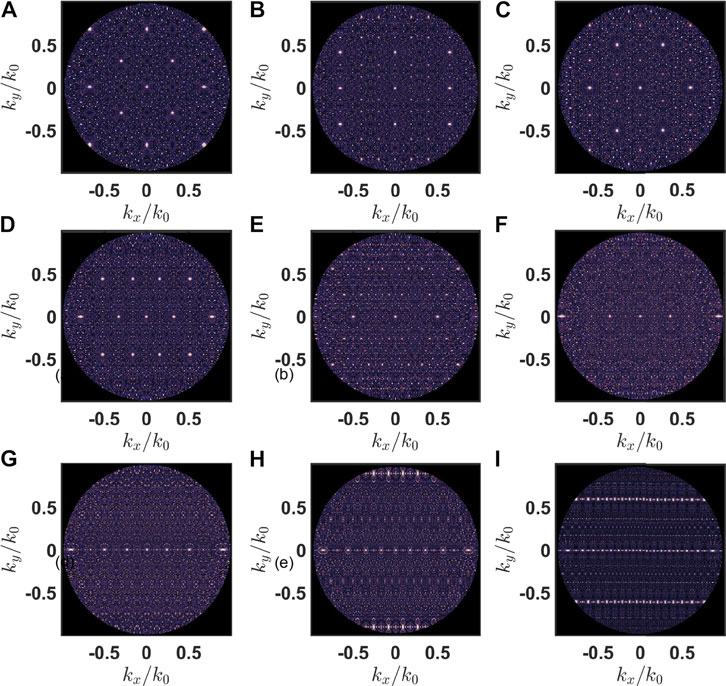
FIGURE 2. Calculated structure factors corresponding to the prime arrays shown in Figure 1. These diffraction patterns are visualized using the fifth root of the intensity to enhance the contrast.
2.4 Spacing Analysis of Complex Primes
Traditional spectral Fourier analysis alone is unsuitable for the characterization of the local structural features of aperiodic point patterns and must be complemented by the interdisciplinary methods of spatial statistics [21, 25].
In particular, in what follows we will focus on graph theory methods to further investigate the structure and connectivity properties of CPAs. In order to better understand the unique geometrical features of the CPAs, it is instructive to first perform spatial Delaunay triangulation analysis using color-coded edge lengths in order to visualize the distribution of distances between neighboring primes in the different structures [25, 54]. The Delaunay triangulation provides a convenient way to impose a graph structure onto the CPAs and this approach can also be employed to study the diffusive transport through arbitrary point patterns [22, 44]. In Figure 3 we display the color-coded Delaunay triangulations for all the investigated CPAs. The edge length is color-coded with increasing numerical values from blue to red color. In panels (a) and (c) we observe that the CPAs of the fields
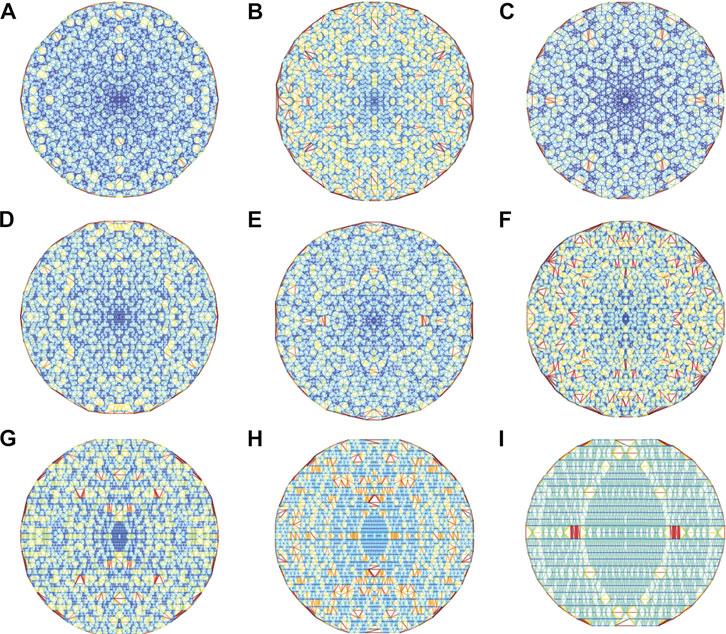
FIGURE 3. (A–I) Delaunay triangulation with color-coded edge according to their lengths of the point patterns displayed in Figure 1. The edge lengths increase from blue (i.e., the shortest edge of the Delaunay triangulation of each CPA) to red (i.e., the longest edge of the Delaunay triangulation of each CPA).
We then study the distribution of the spacing of primes in the CPAs by computing the statistical distributions of the edge lengths of the Delaunay triangulations and by comparing them with the nearest-neighbor distances obtained from the corresponding point patterns. Our results are summarized in the histogram plots shown in Figure 4 and confirm that only few discrete values of nearest-neighbor distances and edge lengths can be obtained in all cases. The non Gaussian nature of these edge distributions unveils structural correlations that markedly separate the aperiodic behavior of CPAs from the well-characterized case of Poisson point patterns [21]. Interestingly, the occurrence of only few values of the nearest-neighbor distances in such large-scale aperiodic sequences is also observed in uniform sequences modulo 1, which display a complex quasi-periodic behavior [55–57]. In this case, the nearest neighbor spacing can only assume three values [55]. In order to extend our geometrical approach, we will introduce in the next section additional metrics that deepen our understanding of the salient geometrical and local connectivity features of the graphs associated with CPAs, with important implications for the transport and localization of light in these complex structures.
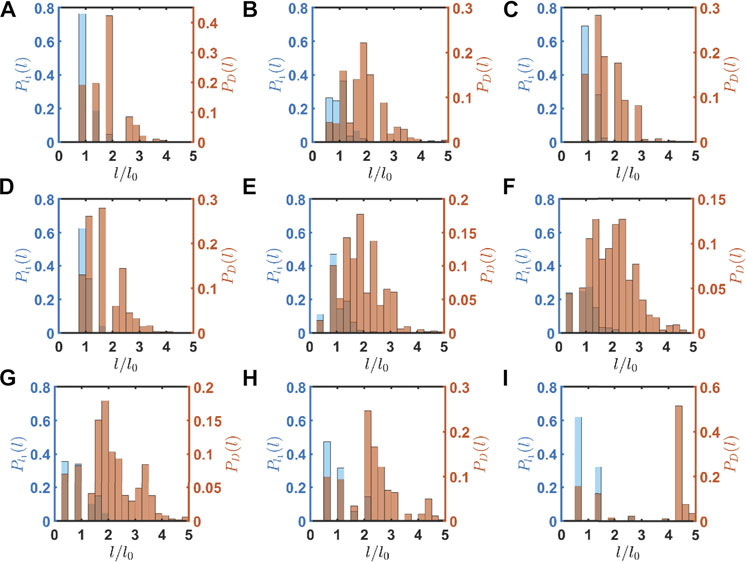
FIGURE 4. Panels (A–I) show the probability density function
2.5 Graph Theory Analysis of Complex Primes
In this section, we apply several quantitative metrics from graph theory to better analyze the distinctive correlation and connectivity properties of the investigated CPAs. In particular, geometrical and topological parameters will be constructed from the graph structure of the Delaunay triangulation associated with each point pattern. In Table 1, we report the computed graph-based topological parameters associated with the unweighted and weighted Delaunay triangulation of each CPA. To facilitate understanding, we provide below a brief introduction to all the considered graph parameters.
We first consider the average node degree ⟨D⟩ of the CPAs, which is the average number of edges per node. We can obtain ⟨D⟩ from the diagonal entries of the graph Laplacian matrix [22]. Interestingly, we notice that the average node degree does not vary significantly across the different structures due to the homogeneous nature of the corresponding Delaunay graphs. However, small variations can be observed when considering the Pearson correlation coefficient R, also known as the assortativity coefficient. This coefficient measures the spatial correlations between nodes with similar degree values, and it is computed as:
where kj is the node degree of the jth node, q (kj) = (kj + 1)p (kj + 1)/∑ikip (ki) and
where NT = Tr (A3)/6 is the number of triangles, A is the graph adjacency matrix, and P2 is the number of paths composed of two edges in the graph that can be obtained by the formula
Here, Ri is the redundancy of vertex i, defined as the mean number of connections from a neighbor of i to the other neighbors of i [22, 25]. This quantity measures how close nodes and their neighbors are to forming their own complete graph [22]. As we can appreciate from Table 1, the non Euclidean structures generally outperform their Euclidean counterparts also with respect to this quantitative metric, as the nodes of these graphs are more likely to form complete subgraphs with their neighboring vertices. This can be observed especially in Figure 3F–I where the primes located within the central elliptic-shaped regions form complete subgraphs with their neighboring vertices. This explains the increase in CWS as |d| rises, since the number of points in the elliptical-shaped region increases with |d|. On the other hand, the algebraic connectivity (AC) of a graph is a measure on how well-connected is the graph overall. It is defined as the second smallest eigenvalue of the graph Laplacian matrix [22]. We observe in Table 1 that the AC of non Euclidean structures rapidly decreases as the radicand d of the corresponding quadratic field increases.
We now consider the analysis of weighted graphs where the weight of each edge is equal to the Euclidean distance between the two neighboring vertices. For a given vertex vi, the weighted clustering coefficient
where wij is the weight on the edge connecting vertices vi and vj, while si is the strength of vertex vi defined by the summation ∑jwij in which j ranges over all adjacent vertices to vi [59]. In Table 1, we report the weighted clustering coefficient averaged over all vertices in the graph, which we denote as Cw. The small difference observed in Table 1 between the weighted clustering coefficient and the Watts-Strogatz index reflects the fact that the local clustering behavior of the CPAs is independent of the length between edges. Finally, we computed the vertex entropy averaged over all the vertices of each CPA graphs. The entropy on vertex vi is denoted by
where m ranges over all adjacent vertices vm of the vertex vi and qi,m is defined as q = wi,m/∑jwi,j, where wi,j is the weight of the edge connecting vertex vi and vj and j ranges over all adjacent vertices of vi. We observe a decreasing trend in nodal entropy from the non Euclidean CPAs that correlates well with the previously discovered drop of their AC. The data in Table 1 establish the particular importance of the AC and the nodal entropy as sensitive characterization parameters for the geometrical analysis of CPAs and provide a comprehensive set of metrics for the development of structure-property relationships. By addressing the challenging moat problem, in the next section we will provide an initial discussion of the connection between the transport and the structural properties of CPAs.
2.6 Transport and the Moat Problem
Diffusive transport through complex systems can be described in a first approximation using the tools of spectral graph theory [22, 58]. In this simple picture, a scalar quantity diffuses over time through the edges of the graph with a diffusion dynamics determined by the spectral properties of its adjacency matrix (more precisely of its graph Laplacian operator). Therefore, understanding the geometry and connectivity characteristics of the graphs imposed over a complex point pattern can provide invaluable information on the nature of its transport properties, and help identifying robust structure-property relationships. Moreover, the network or graph approach to diffusion through two-dimensional CPAs has a direct connection with one of the unsolved problems in number theory, i.e., the Gaussian moat problem [61]. A general moat problem asks whether it is possible to walk to infinity by taking steps of bounded length on primes. When considering rational primes (prime numbers in
In order to extend this approach to all the considered CPAs, here we use the graph created from the Delaunay triangulation to computationally explore the farthest distances reachable in the CPAs, given a maximum step size. We find that the previously introduced AC and nodal entropy parameters of the CPAs play indeed an important role in this context and largely control the transport properties of CPAs. To quantitatively study this problem we first create weighted graphs by assigning a weight to each edge equal to the distance between the two primes connected by that edge. We then can find the farthest distance reached for a given moat value k by removing all the edges with lengths greater than k. In the resulting graph, the node associated with the point of largest norm in the Minimum Spanning Tree (MST) is called the Frontier prime [22, 44]. The norm of this prime yields the farthest distance reached with a maximum step size k. Since this is a hard computational problem, the symmetry of the structures must be exploited to limit the investigation to only a portion of the structures [44]. Specifically, an octant of the plane is considered for the Gaussian primes, a 12th of the plane for the Eisenstein primes, and a quadrant of the plane for all the remaining CPAs [44]. Representative examples of this method are shown in Figure 5. For this analysis we have investigated largest systems with up to N = 3 × 104 particles. In particular, in panels (a) and (b) we show the farthest primes reached when the considered moat value is k = 2 and
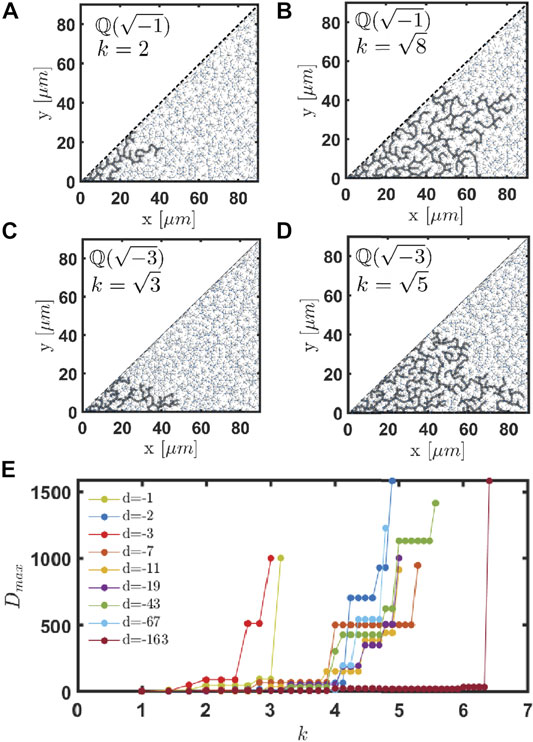
FIGURE 5. Minimum spanning tree analysis applied to the Gaussian prime array when the maximum allowed edge length k (also named moat value) is equal to 2 panel (A) and
3 Wave Transport Through Prime Number Landscapes
We now investigate the spectral and wave transport properties of vertically-polarized electric dipoles spatially arranged according to the distributions of primes in imaginary quadratic fields. As already introduced in section 2.2, we will focus here only on the nine structures that are UFDs. Multiple scattering effects are studied by analyzing the properties of the Green’s matrix that is defined as:
where the elements
with H0 (k0|ri −rj|) the zero-order Hankel function of the first kind, k0 the wavevector of light, and ri the position of the i-th scatterer in the array. The non-Hermitian matrix (13) describes the electromagnetic coupling among the dipoles and it enables the systematic study of the scattering properties of two-dimensional (2D) waves with an electric field parallel to the invariance axis of the CPAs (i.e., z-field component) [66]. The real and the imaginary parts of the complex eigenvalues Λn of Eq. 13 correspond to the detuned frequency ω0—ω and decay rate Γn (both normalized to the resonant width Γ0 of an isolated dipole) of the scattering resonances of the system [28, 65, 67]. Although the 2D model defined by the matrix (13) does not take into account the vector nature of light [13, 15, 27], it still provides robust physical information on light localization in complex 2D media [28, 65, 67]. Moreover, this 2D model has been recently employed to describe the “disorder-induced” transparency in high-density hyperuniform materials [66], to correctly describes the coupling between two-level atoms in a structured reservoir [68, 69], and to design aperiodic arrays for the efficient generation of two-photon processes [20]. In addition, it can also be conveniently utilized as the starting point for the design of three-dimensional photonic devices based on the membrane geometry [70, 71]. We will study the Thouless number g and the level spacing statistics in the low and high optical density ρλ2 regimes by numerically diagonalizing the N × N matrix (14), where ρ is the number of scatterers per unit area and λ is the optical wavelength. In the following, we will focus on a subset of four representative arrays that fully capture the main features of the wave transport properties of CPAs. In particular, we will discuss the CPAs in the associated quadratic fields
We find that at low optical density (i.e., ρλ2 = 106), all the investigated systems are in the diffusive regime. In fact, their eigenvalue distributions, color-coded according to the log 10 of the modal spatial extent (MSE), do not show the formation of any long-lived scattering resonances. The MSE parameter quantifies the spatial extension of a given scattering resonances Ψi of the system and it is defined as [72]:
To gain more insight on the transport properties of CPAs, we study the behavior of the Thouless number g as a function of the frequency ω [15, 27, 67]. Specifically, we sample the real parts of the eigenvalues Λn in 500 equi-spaced intervals and we calculate the Thouless number in each frequency sub-interval by using the relation [15, 27]:
The symbol
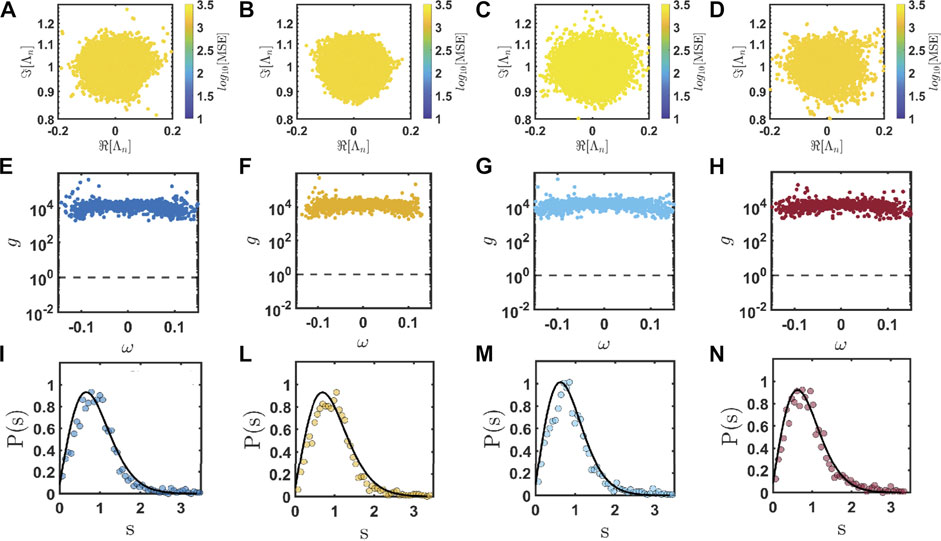
FIGURE 6. Eigenvalues distribution of the Green’s matrix (13) in the low scattering regime (i.e., ρλ2 = 10–6) for two representative Euclidean [panels (A,B)] and non Euclidean [panels (C,D)] CPA. In particular, panels (A–D) refer to the arrays generated by following the prime elements in the complex quadratic fields
To corroborate our findings, we have analyzed the probability density function of the first-neighbor level spacing statistics of the complex Green’s matrix eigenvalues P(s), where s = |ΔΛ|/⟨|ΔΛ|⟩ is the nearest-neighbor Euclidean spacing of the complex eigenvalues |ΔΛ| = |Λn+1 −Λn| normalized to its average value. The study of level statistics provides important information on the electromagnetic propagation in both closed and open scattering systems [73, 74]. In particular, the concept of level repulsion (i.e., P(s) = 0 when s goes to zero) is used to characterize the degree of spatial overlap between the resonant scattering modes of arbitrary systems [75]. In fact, the level statistics analysis allows one to unambiguously discriminate between a decloalized (diffusive) regime characterized by level repulsion and a localization regime characterized by level clustering (i.e., by the absence of level repulsion) as a function of ρλ2. We have shown in Ref. [17] that the distribution of level spacing for the Gaussian and Eisenstein prime arrays in the low scattering regime manifests level repulsion described by the critical cumulative probability defined as [76]:
where μ and Ac are fitting parameters. The results shown in Figure 6I–L and in Supplementary Figure S1 of the Supplementary Materials establish the critical level spacing statics as a robust property for all the other investigated CPAs as well at small optical density. The critical cumulative probability was successfully applied to describe the energy level spacing distribution of an Anderson Hamiltonian containing 106 lattice sites at the critical disorder value, i.e., at the metal-insulator threshold where it is known that all the wave functions exhibit multifractal scaling properties [76]. Our findings demonstrate the applicability of critical statistics to CPAs in the weakly scattering regime reflecting the singular-continuous nature of their diffraction spectra that support critically localized eigenmodes with self-similar scaling properties (see also Supplementary Material for more details on the singular-continuous nature of the investigated arrays).
On the other hand, at large optical density ρλ2 = 5.5, we observe the appearance of spatially confined long-lived scattering resonances, as shown in Figure 7A–D. Specifically, clear dispersion branches populated by scattering resonances that are localized over small clusters of dipoles are forming near ω ≈ 0 in all the investigated CPAs (see also the Supplementary Material for additional details). Moreover, Figure 7A–C show the formation of spectral gap regions where the critical scattering resonances reside, demonstrating the effect of local correlations on wave interference across the structures. Critical modes in aperiodic systems are spatially extended and long-lived resonances with spatial fluctuations at multiple length scales characterized by a power-law scaling behavior [18, 77, 78]. Interestingly, we found that the CPA associated to
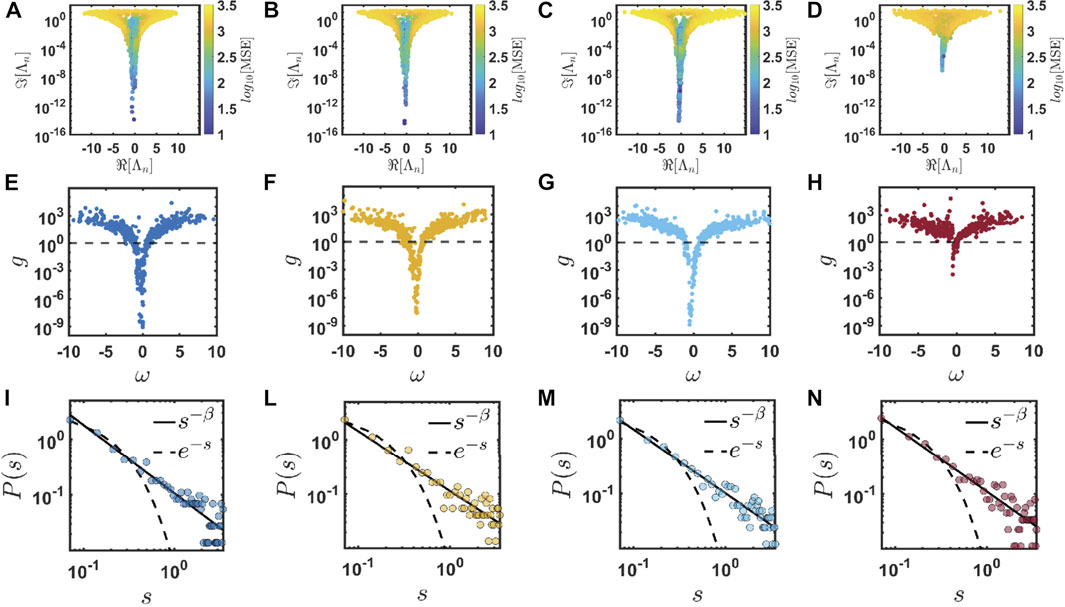
FIGURE 7. Complex eigenvalue distributions, Thouless number, and level spacing statistics of the same structures analyzed in Figure 6 are reported, respectively, in panels (A–D), (E–H), and (I–N) when ρλ2 = 5.5. These data not only show a Thouless number g < 1 at ω ≈ 0, but also show that P(s) describes level clustering with a power-law scaling [continuous black lines in panels (I–N)]. The Poisson distribution that is characteristic of uniform random systems is also reported with a black dashed line as a comparison.
The presence of a clear delocalization localization transition in the analyzed CPAs is also confirmed by the behavior of their level spacing statistics at large optical density. Under this condition, we observe a clear level clustering effect that is fundamentally different from the Poisson statistics predicted for homogeneous random media (black-dotted lines in Figure 7I–L) and describing non-interacting, exponentially localized energy levels [75, 79]. In contrast, the level spacing distributions observed in all CPAs are well-reproduced considering the inverse power law scaling curve P(s) ∼ s−β that is displayed by the continuous black lines (see also Supplementary Figure S2 of the Supplementary Materials). In the context of random matrix theory, it has been demonstrated that the power-law distribution describes complex systems with multifractal spectra that produce uncountable sets of hierarchical level clustering [80, 81]. Moreover, this power-law scaling appears to universally describe the transport physics, for values of the exponent β in the range 0.5 < β < 2, of complex systems exhibiting anomalous diffusion. These are correlated random systems in which the width of a propagating wavepacket σ2 increases upon propagation according to t2ν with ν ∈ [0, 1] [80]. Specifically, such a behavior was observed in one-dimensional scattering systems characterized by incommensurate sinusoidal modulations [81], in quasi-periodic Fibonacci structures [82], in a family of tight-binding Hamiltonians defined on two-dimensional octagonal quasi-periodic tilings [83], and more recently, in three-dimensional scattering arrays designed from sub-random sequences [15]. The exponents β and ν are connected through the relation [80, 81, 84]:
where
Finally, Figure 8A,B display the scaling, as a function of the number N of prime elements, of the minimum values of the Thouless number for two representative CPAs corresponding to the quadratic fields
with lt the transport mean free path and
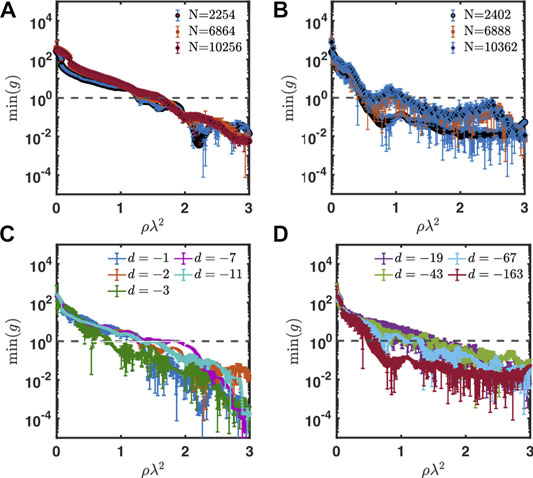
FIGURE 8. Panels (A) and (B) show the scaling with respect to the system size of the minimum value of the Thouless number as a function of ρλ2 near by the DLT-threshold. Panel (A) refers to the CPA in the
4 Multifractality of Local Density of States
The decay dynamics of a light emitter embedded in a complex dielectric environment can be rigorously understood by computing its local density of states (LDOS) and the corresponding Purcell enhancement factor as a function of frequency. The knowledge of the LDOS spectra allows one to accurately determine the spectral locations of the resonant modes with the highest quality factors, such as those that are located near the bandgap regions [16, 25, 26, 54, 70–72, 87]. In order to characterize the emission dynamics in these complex aperiodic environments, we have computed the enhancement of the LDOS with respect to its free space value, or the Purcell spectrum, for all the CPAs consisting of approximately 1,000 electric dipoles with the electric polarizability
where ri is the position of the scatterer i and G (r, rs; ω) is the Green function (14) [68]. For a system with N scattering elements, the linear system (20) can be solved numerically. Once the exciting field at rs is known, the Purcell spectrum P (rs; ω) can be evaluated through the formula
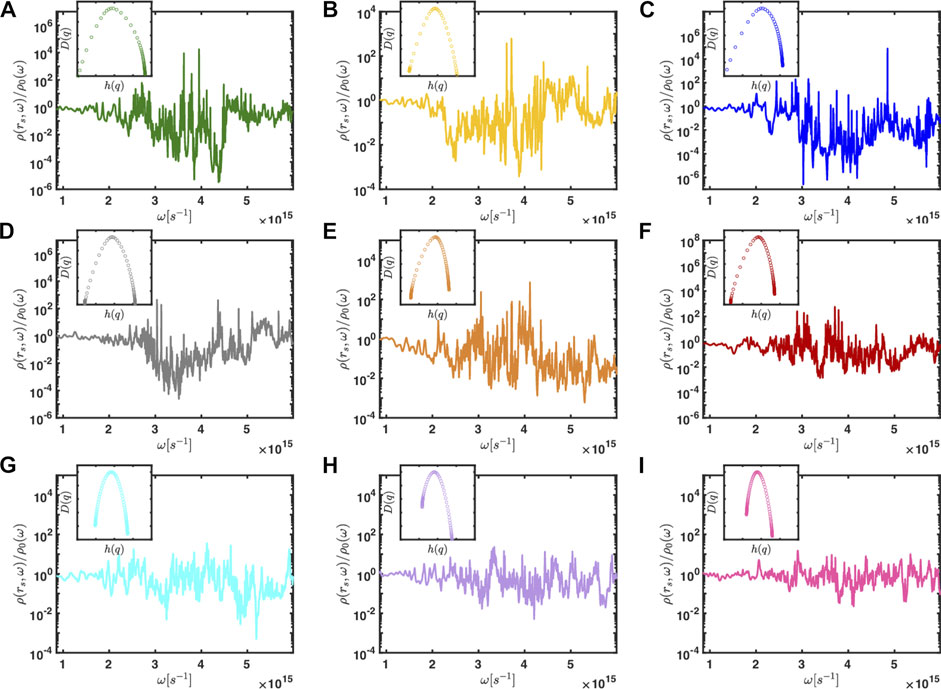
FIGURE 9. (A–I) LDOS/Purcell enhancement as a function of frequency ω of vertically polarized dipoles (i.e., electric field along the z) spatially arranged according to the distributions of complex primes in the imaginary quadratic fields shown in Figure 1. The insets show the corresponding multifractal spectra D(q) as a function of h(q). All the multifractal spectra are reported on the same scale with D(q) ∈ [0, one] and h(q) ∈ [0, 4].
In order to characterize the multifractal scaling of the LDOS fluctuations observed in Figure 9 for all the CPAs we apply Multifractal Detrended Fluctuation Analysis (MDFA) [24] using the numerical routines developed by Ihlen for the study of non-stationary complex signals [23]. The MDFA is a powerful technique that extends the traditional Detrended Fluctuation Analysis (DFA) [92] to the case of non-stationary time series with multifractal scaling properties. This is achieved by considering the scaling of their fluctuations with respect to polynomial trends defined over sub-intervals of the analyzed signals (i.e., local detrending). The local nature of the scaling procedure is essential because, in contrast to homogeneous fractals (or monofractals), the scaling of multifractals is locally defined around each point. More precisely, the scaling behavior around any point of a general multifractal measure μ is accounted by its local (i.e., position dependent) power law
In our analysis the multifractal LDOS signal xt is regarded as a discrete series of data points labelled by the integer parameter
where:
Moreover, Xt is subdivided into time windows of size n samples and Yt denotes the piecewise sequence of approximating trends obtained by local least squares fits. Finally, ⟨x⟩ is the mean value of the analyzed time series corresponding to the LDOS signal. Finally, the multifractal spectra of the LDOS, shown in the insets of Figure 9 for the corresponding CPA, are computed from the mass exponent τ(q) using the Legendre transform [20, 24]:
The broad and downward concavities of the multifractals spectra of the LDOS of CPAs are indicative of the strong multifractal behavior of these complex systems [18, 20]. The width Δh(q) of the support of the multifractal spectra is directly related to the degree of spatial non-uniformity of the corresponding signals [18]. Our results demonstrate that the strongest LDOS multifractality occurs for the Eisenstein prime structures and it drops significantly for the more non Eucliedean CPAs that are characterized by more regular geometries. This trend is consistent with the reduction in nodal entropy and algebraic connectivity that was previously identified for non Eucliedean CPAs.
We are now well-positioned to establish robust structure-property relationships valid for all the investigated CPAs by correlating their structural and spectral information. In particular, here we investigate the connection between geometrical and transport properties by showing in Figure 10 the dependence of the critical optical density
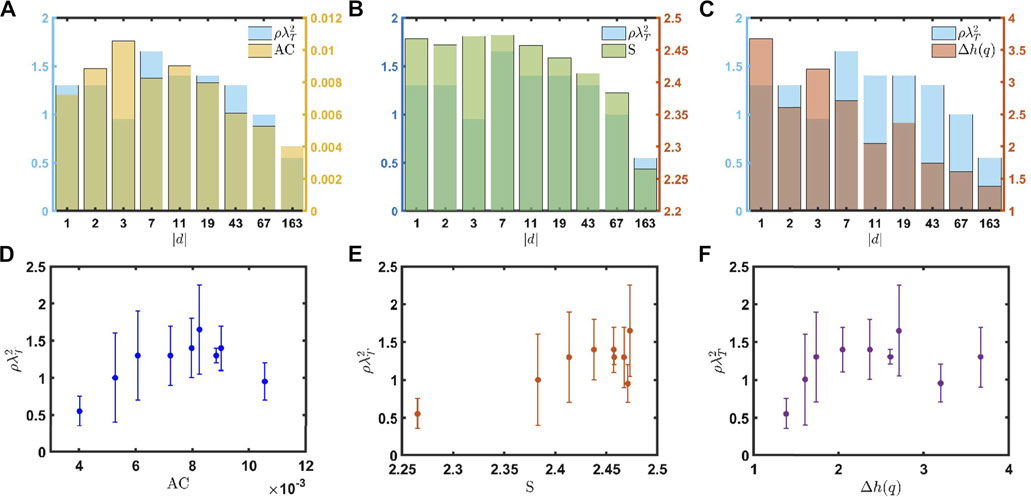
FIGURE 10. Histograms of the estimated values of the DLT-threshold (
5 Prime Numbers in the Quantum Regime: Rabi Splitting
Spectral fractality has profound implications on the relaxation dynamics of quantum sources [20, 94]. In the following section, we will address the decay rate of a two-level atom (TLA) with transition frequency
As a proof-of-concept demonstrator, we focus here on the radiation from Eisenstein prime arrays. These structures are the best candidate ones to achieve strong light-matter interaction. In fact, based on our previous analysis, the Eisenstein prime arrays possess the most compact (high-density) and complex aperiodic geometry characterized by the highest nodal entropy value and the broadest multifractal LDOS spectrum. In addition, among all the CPAs the Eisenstein structures also display the highest degree of rotational symmetry, which favors the formation of spectral badgap regions in low-index photonic environments [99] and, in combination with aperiodic order, is known to give rise to highly-localized optical modes [27, 70, 71]. This feature is clearly visible in Figure 11A, where we show the Purcell spectrum P (rs; ω) = ρ(rs, ω)/ρ0(ω) evaluated at the center of an Eisenstein array with N = 1,062 scattering particles. A broadband distribution of highly-confined band-edge resonant modes can be observed in the Purcell spectrum of this structure. An enlarged view of the highest peak of P (rs; ω) is shown along with its Lorentzian fit in Figure 11B. This localized optical mode, shown in the inset of panel (b), has an eigenfrequency ω = 4.85 × 1015s−1, and an effective linewidth Γ = 8.8 × 109s−1, yielding a quality factor Q = ω/Γ = 1.5 × 105 and a Purcell enhancement factor P = 5.5 × 105. The inset of panel (b) is computed using a square grid of vertically-polarized electric dipoles with a resolution of 19 nm (i.e., almost 5 × 105 dipoles are considered). We now use this highly-localized mode to demonstrate numerically the strong coupling regime following the approach described in Refs. [66, 68]. The computational analysis proceeds as follows: first, we add an extra scattering dipole at position rs with the electric polarizability:
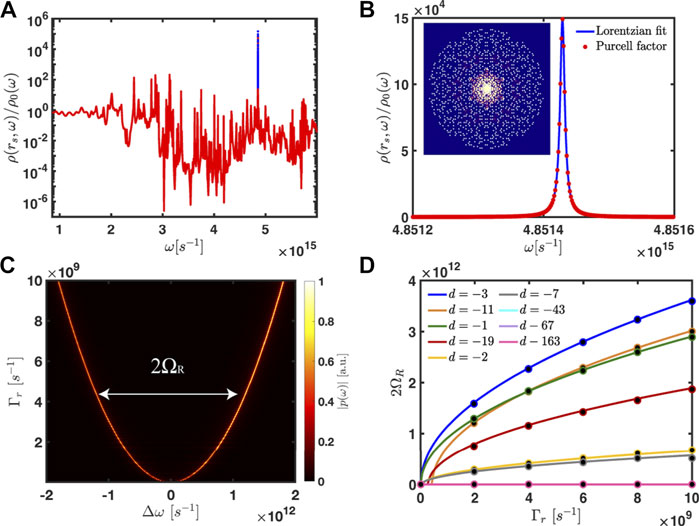
FIGURE 11. (A) LDOS enhancement/Purcell factor as a function of frequency ω for vertically polarized electric dipoles spatially according to the Eisenstein prime arrays evaluated at the center of the structure. The blue markers identify the optical mode with the largest Purcell enhancement that is fitted by a Lorentzian lineshape, as reported in panel (B). Panel (C) displays the strong coupling between a TLA, positioned at the center of the structure, and the optical mode reported in panel (b). The Rabi splitting is evaluated numerically by calculating the absolute value of the induced dipole moment |p(ω)| of the TLA as a function of the detuned frequency Δω and the radiative linewidth Γr. (D) Rabi splitting 2ΩR of a TLA coupled with the optical modes with the largest Purcell enhancement factor for each investigated CPA. The continuous lines are the analytical predictions obtained from the analysis of the complex poles of the dressed polarizability while the markers indicate the numerical data.
The parameters Γr, and Γnr are, respectively, the radiative and intrinsic nonradiative linewidth [66, 68]. We then tune its resonance frequency
where the locally exciting field on the TLA is given by:
By substituting Eq. 26 into Eq. 25, we can evaluate the exciting field on each of the N scatterers in the CPA dielectric environment by solving the self-consistent Foldy-Lax equations:
where M is the N × N matrix defined by:
Once the locally exciting fields on each scattering dipole are known, we can compute the induced dipole moment of the probe scatterer pTLA = ϵ0αTLA(ω)ETLA (rs, ω), whose absolute value yields the Rabi splitting [66, 68]. Figure 11C shows the resulting spectrum as a function of the detuned frequency Δω and the radiative linewidth Γr. We note that the single Lorentzian peak is now split into two symmetric peaks by increasing Γr, which demonstrates the onset of Rabi-splitting in the system.
To provide a comprehensive overview of the strong coupling regime of CPA dielectric environments, we have extended our numerical study to all the investigated CPAs. The results of this analysis are presented in Figure 11D. The markers denote the numerical results evaluated by solving Eq. 27, while the continuous lines refer to the analytical expression of the Rabi frequency ΩR derived by analyzing the poles of the dressed polarizability of the system
6 Conclusion
In conclusion, we have presented a comprehensive analysis of the structural, spectral, and localization properties of novel aperiodic arrays of scattering dipoles that inherit the intrinsic complexity of prime numbers in imaginary quadratic fields. We have presented a theoretical analysis that combines the interdisciplinary methods of spatial statistics and graph theory analysis of point patterns with the rigorous Green’s matrix spectral approach to the multiple scattering problem of optical waves. Our work has unveiled the relevant structural properties that result in a wave localization transition in the investigated structures. Specifically, we have demonstrated the onset of a Delocalization-Localization Transition (DLT) by a comprehensive analysis of the spectral properties of the Green’s matrix and the Thouless number of these systems as a function of the optical density. Moreover, we showed that CPAs are gapped systems with a multifractal spectrum of localized resonances resulting in a far-richer scattering and localization behavior compared to periodic and uniform random structures. Furthermore, we establish a connection between their localization, multifractality, and graph connectivity properties. Finally, we employed a semi-classical approach to demonstrate and characterize the strong coupling regime of quantum emitters embedded in these novel aperiodic environments. This study provides access to engineering design rules for the fabrication of novel and more efficient classical and quantum sources as well as photonic devices with enhanced light-matter interaction based on the intrinsic structural complexity of prime numbers in imaginary quadratic fields. Our comprehensive analysis is meant to stimulate the development of novel design principles to achieve broadband enhancement of light-matter interactions in both the classical and quantum regimes.
Data Availability Statement
The data that support the findings of this study are available from the corresponding author upon reasonable request.
Author Contributions
LN. conceived, lead, supervised the research activities, and wrote the manuscript with critical feedback from all the authors. All the authors performed numerical computations, analyzed, and organized the final results. All authors contributed to discussions and manuscript revisions.
Conflict of Interest
The authors declare that the research was conducted in the absence of any commercial or financial relationships that could be construed as a potential conflict of interest.
Publisher’s Note
All claims expressed in this article are solely those of the authors and do not necessarily represent those of their affiliated organizations or those of the publisher, the editors, and the reviewers. Any product that may be evaluated in this article, or claim that may be made by its manufacturer, is not guaranteed or endorsed by the publisher.
Acknowledgments
LN acknowledges the support from the Army Research Laboratory under Cooperative Agreement Number W911NF-12-2-0023.
Supplementary Material
The Supplementary Material for this article can be found online at: https://www.frontiersin.org/articles/10.3389/fphy.2021.723456/full#supplementary-material
References
2. Lagendijk A, Tiggelen Bv., Wiersma DS. Fifty Years of Anderson Localization. Phys Today (2009) 62:24–9. doi:10.1063/1.3206091
3. Wiersma DS. The Physics and Applications of Random Lasers. Nat Phys (2008) 4:359–67. doi:10.1038/nphys971
4. Cao H, Zhao YG, Ho ST, Seelig EW, Wang QH, Chang RPH. Random Laser Action in Semiconductor Powder. Phys Rev Lett (1999) 82:2278–81. doi:10.1103/physrevlett.82.2278
5. Sebbah P, Hu B, Klosner JM, Genack AZ. Extended Quasimodes within Nominally Localized Random Waveguides. Phys Rev Lett (2006) 96:183902. doi:10.1103/physrevlett.96.183902
6. Redding B, Choma MA, Cao H. Speckle-free Laser Imaging Using Random Laser Illumination. Nat Photon (2012) 6:355–9. doi:10.1038/nphoton.2012.90
7. Vellekoop IM, Lagendijk A, Mosk AP. Exploiting Disorder for Perfect Focusing. Nat Photon (2010) 4:320–2. doi:10.1038/nphoton.2010.3
8. Boschetti A, Taschin A, Bartolini P, Tiwari AK, Pattelli L, Torre R, et al. Spectral Super-resolution Spectroscopy Using a Random Laser. Nat Photon (2020) 14:177–82. doi:10.1038/s41566-019-0558-4
9. Sheng P. Introduction to Wave Scattering, Localization and Mesoscopic Phenomena, 88. Berlin: Springer Science & Business Media (2006).
10. Akkermans E, Montambaux G. Mesoscopic Physics of Electrons and Photons. Cambridge: Cambridge University Press (2007).
11. Segev M, Silberberg Y, Christodoulides DN. Anderson Localization of Light. Nat Photon (2013) 7:197–204. doi:10.1038/nphoton.2013.30
12. Skipetrov SE, Page JH. Red Light for anderson Localization. New J Phys (2016) 18:021001. doi:10.1088/1367-2630/18/2/021001
13. Skipetrov SE, Sokolov IM. Absence of anderson Localization of Light in a Random Ensemble of point Scatterers. Phys Rev Lett (2014) 112:023905. doi:10.1103/PhysRevLett.112.023905
14. Bellando L, Gero A, Akkermans E, Kaiser R. Cooperative Effects and Disorder: A Scaling Analysis of the Spectrum of the Effective Atomic Hamiltonian. Phys Rev A (2014) 90:063822. doi:10.1103/physreva.90.063822
15. Sgrignuoli F, Dal Negro L. Subdiffusive Light Transport in Three-Dimensional Subrandom Arrays. Phys Rev B (2020) 101:214204. doi:10.1103/physrevb.101.214204
16. Dal Negro L, Boriskina SV. Deterministic Aperiodic Nanostructures for Photonics and Plasmonics Applications. Laser Photon Rev (2012) 6:178–218. doi:10.1002/lpor.201000046
17. Wang R, Pinheiro FA, Dal Negro L. Spectral Statistics and Scattering Resonances of Complex Primes Arrays. Phys Rev B (2018) 97:024202. doi:10.1103/physrevb.97.024202
18. Sgrignuoli F, Gorsky S, Britton WA, Zhang R, Riboli F, Dal Negro L. Multifractality of Light in Photonic Arrays Based on Algebraic Number Theory. Commun Phys (2020) 3:1–9. doi:10.1038/s42005-020-0374-7
19. Sgrignuoli F, Chen Y, Gorsky S, Britton WA, Dal Negro L. Optical Rogue Waves in Multifractal Photonic Arrays. Phys Rev B (2021) 103:195403. doi:10.1103/physrevb.103.195403
20. Dal Negro L, Chen Y, Gorsky S, Sgrignuoli F. Aperiodic Bandgap Structures for Enhanced Quantum Two-Photon Sources. JOSA B (2021) 38:C94–C104. doi:10.1364/josab.430551
21. Illian J, Penttinen A, Stoyan H, Stoyan D. Statistical Analysis and Modelling of Spatial point Patterns, 70. Chichester, West Sussex: John Wiley & Sons (2008).
23. Ihlen EAF. Introduction to Multifractal Detrended Fluctuation Analysis in Matlab. Front Physio (2012) 3:141. doi:10.3389/fphys.2012.00141
24. Kantelhardt JW, Zschiegner SA, Koscielny-Bunde E, Havlin S, Bunde A, Stanley HE. Multifractal Detrended Fluctuation Analysis of Nonstationary Time Series. Physica A: Stat Mech its Appl (2002) 316:87–114. doi:10.1016/s0378-4371(02)01383-3
25. Dal Negro L, Wang R, Pinheiro F. Structural and Spectral Properties of Deterministic Aperiodic Optical Structures. Crystals (2016) 6:161. doi:10.3390/cryst6120161
26. Dal Negro LD, Chen Y, Sgrignuoli F. Aperiodic Photonics of Elliptic Curves. Crystals (2019) 9:482. doi:10.3390/cryst9090482
27. Sgrignuoli F, Wang R, Pinheiro FA, Dal Negro L. Localization of Scattering Resonances in Aperiodic Vogel Spirals. Phys Rev B (2019) 99:104202. doi:10.1103/physrevb.99.104202
28. Lagendijk A, Van Tiggelen BA. Resonant Multiple Scattering of Light. Phys Rep (1996) 270:143–215. doi:10.1016/0370-1573(95)00065-8
29. Skipetrov SE, Sokolov IM. Magnetic-field-driven Localization of Light in a Cold-Atom Gas. Phys Rev Lett (2015) 114:053902. doi:10.1103/PhysRevLett.114.053902
30. Skipetrov S. Finite-size Scaling Analysis of Localization Transition for Scalar Waves in a Three-Dimensional Ensemble of Resonant point Scatterers. Phys Rev B (2016) 94:064202. doi:10.1103/physrevb.94.064202
31. Skipetrov SE. Localization of Light in a Three-Dimensional Disordered crystal of Atoms. Phys Rev B (2020) 102:134206. doi:10.1103/physrevb.102.134206
33. Goldman JR. The Queen of Mathematics. A Historically Motivated Guide to Number Theory. Natick, MA: A. K. Peters Ltd. (2004).
34. Boyer CB, Merzbach UC. A History of Mathematics. Chichester, West Sussex: John Wiley & Sons (2011).
35. Wiles A. Modular Elliptic Curves and Fermat's Last Theorem. Ann Mathematics (1995) 141:443–551. doi:10.2307/2118559
36. Edwards HM. Fermat’s Last Theorem: A Genetic Introduction to Algebraic Number Theory, 50. Berlin: Springer Science & Business Media (1996).
38. Cohen H. A Classical Invitation to Algebraic Numbers and Class fields. New York): Springer-Verlag (1978).
39. Ireland K, Rosen M. A Classical Introduction to Modern Number Theory. 2nd ed. New York: Springer-Verlag (1990).
40. Stewart I, Tall D. Algebraic Number Theory and Fermat’s Last Theorem. 3rd ed. Boca Raton: A. K. Peters Ltd. Canada (2002).
42. Pinter CC. A Book of Abstract Algebra. North Chelmsford, Chelmsford, MA: Courier Corporation (2010).
45. Tao T. The Dichotomy between Structure and Randomness, Arithmetic Progressions, and the Primes. arXiv preprint math/05121142005.
46. Tao T. The Gaussian Primes Contain Arbitrarily Shaped Constellations. J Anal Math (2006) 99:109–76. doi:10.1007/bf02789444
47. Goldfeld D. Gauss' Class Number Problem for Imaginary Quadratic fields. Bull Amer Math Soc (1985) 13:23–38. doi:10.1090/s0273-0979-1985-15352-2
48. Ayoub RG, Chowla S. On Euler's Polynomial. J Number Theor (1981) 13:443–5. doi:10.1016/0022-314x(81)90035-4
50. Stein M, Ulam SM. An Observation on the Distribution of Primes. The Am Math Monthly (1967) 74:43–4. doi:10.2307/2314055
51. Baake M, Grimm U. Mathematical Diffraction of Aperiodic Structures. Chem Soc Rev (2012) 41:6821–43. doi:10.1039/c2cs35120j
53. Dal Negro L. Optics of Aperiodic Structures: Fundamentals and Device Applications. Singapore: Pan Stanford Publishing (2013).
54. Trevino J, Liew SF, Noh H, Cao H, Dal Negro L. Geometrical Structure, Multifractal Spectra and Localized Optical Modes of Aperiodic Vogel Spirals. Opt Express (2012) 20:3015–33. doi:10.1364/oe.20.003015
55. Miller SJ, Takloo-Bighash R. An Invitation to Modern Number Theory. New Jersey: Princeton University Press (2021).
56. Niederreiter H. Low-discrepancy and Low-Dispersion Sequences. J Number Theor (1988) 30:51–70. doi:10.1016/0022-314x(88)90025-x
57. Kuipers L, Niederreiter H. Uniform Distribution of Sequences. North Chelmsford, Chelmsford, MA: Courier Corporation (2012).
59. Barrat A, Barthelemy M, Pastor-Satorras R, Vespignani A. The Architecture of Complex Weighted Networks. Proc Natl Acad Sci (2004) 101:3747–52. doi:10.1073/pnas.0400087101
60. Sen B, Chu SH, Parhi KK. Ranking Regions, Edges and Classifying Tasks in Functional Brain Graphs by Sub-graph Entropy. Sci Rep (2019) 9:1–20. doi:10.1038/s41598-019-44103-8
61. Guy R. Unsolved Problems in Number Theory, Vol. 1. Berlin: Springer Science & Business Media (2004).
62. Gethner E, Wagon S, Wick B. A Stroll through the Gaussian Primes. Am Math Monthly (1998) 105:327–37. doi:10.2307/2589708
63. Philip P. West PP, Brian D. Sittinger BD. A Further Stroll into the Eisenstein Primes. Am Math Monthly (2017) 124:609–20. doi:10.4169/amer.math.monthly.124.7.609
64. Bressoud DM, Wagon S. A Course in Computational Number Theory. Chichester, West Sussex: John Wiley & Sons (2000). p. 384.
65. Rusek M, Orłowski A. Analytical Approach to Localization of Electromagnetic Waves in Two-Dimensional Random media. Phys Rev E (1995) 51:R2763–R2766. doi:10.1103/physreve.51.r2763
66. Leseur O, Pierrat R, Carminati R. High-density Hyperuniform Materials Can Be Transparent. Optica (2016) 3:763–7. doi:10.1364/optica.3.000763
67. Sgrignuoli F, Dal Negro L. Hyperuniformity and Wave Localization in Pinwheel Scattering Arrays. Phys Rev B (2021) 103:224202. doi:10.1103/physrevb.103.224202
68. Cazé A, Pierrat R, Carminati R. Strong Coupling to Two-Dimensional anderson Localized Modes. Phys Rev Lett (2013) 111:053901. doi:10.1103/PhysRevLett.111.053901
69. Bouchet D, Carminati R. Quantum Dipole Emitters in Structured Environments: a Scattering Approach: Tutorial. J Opt Soc Am A (2019) 36:186–95. doi:10.1364/josaa.36.000186
70. Trojak OJ, Gorsky S, Murray C, Sgrignuoli F, Pinheiro FA, Dal Negro L, et al. Cavity-enhanced Light-Matter Interaction in Vogel-Spiral Devices as a Platform for Quantum Photonics. Appl Phys Lett (2021) 118:011103. doi:10.1063/5.0034984
71. Trojak OJ, Gorsky S, Sgrignuoli F, Pinheiro FA, Park S-I, Song JD, et al. Cavity Quantum Electro-Dynamics with Solid-State Emitters in Aperiodic Nano-Photonic Spiral Devices. Appl Phys Lett (2020) 117:124006. doi:10.1063/5.0024719
72. Sgrignuoli F, Mazzamuto G, Caselli N, Intonti F, Cataliotti FS, Gurioli M, et al. Necklace State Hallmark in Disordered 2d Photonic Systems. ACS Photon (2015) 2:1636–43. doi:10.1021/acsphotonics.5b00422
73. Shklovskii BI, Shapiro B, Sears BR, Lambrianides P, Shore HB. Statistics of Spectra of Disordered Systems Near the Metal-Insulator Transition. Phys Rev B (1993) 47:11487–90. doi:10.1103/physrevb.47.11487
74. Escalante JM, Skipetrov SE. Level Spacing Statistics for Light in Two-Dimensional Disordered Photonic Crystals. Sci Rep (2018) 8:11569. doi:10.1038/s41598-018-29996-1
76. Zharekeshev IK, Kramer B. Asymptotics of Universal Probability of Neighboring Level Spacings at the anderson Transition. Phys Rev Lett (1997) 79:717–20. doi:10.1103/physrevlett.79.717
77. Maciá E. Physical Nature of Critical Modes in Fibonacci Quasicrystals. Phys Rev B (1999) 60:10032–6. doi:10.1103/physrevb.60.10032
78. Ryu CS, Oh GY, Lee MH. Extended and Critical Wave Functions in a Thue-morse Chain. Phys Rev B (1992) 46:5162–8. doi:10.1103/physrevb.46.5162
80. Cvitanovic P, Percival I, Wirzba A. Quantum Chaos & Quantum Measurement, 358. Berlin: Springer Science & Business Media (2013).
81. Geisel T, Ketzmerick R, Petschel G. New Class of Level Statistics in Quantum Systems with Unbounded Diffusion. Phys Rev Lett (1991) 66:1651–4. doi:10.1103/physrevlett.66.1651
82. Guarneri I, Mantica G. Multifractal Energy Spectra and Their Dynamical Implications. Phys Rev Lett (1994) 73:3379–82. doi:10.1103/physrevlett.73.3379
83. Benza VG, Sire C. Band Spectrum of the Octagonal Quasicrystal: Finite Measure, Gaps, and Chaos. Phys Rev B (1991) 44:10343–5. doi:10.1103/physrevb.44.10343
84. Dal Negro L, Inampudi S. Fractional Transport of Photons in Deterministic Aperiodic Structures. Sci Rep (2017) 7:2259. doi:10.1038/s41598-017-02170-9
85. John S. Strong Localization of Photons in Certain Disordered Dielectric Superlattices. Phys Rev Lett (1987) 58:2486–9. doi:10.1103/physrevlett.58.2486
86. Gupta BC, Ye Z. Localization of Classical Waves in Two-Dimensional Random media: A Comparison between the Analytic Theory and Exact Numerical Simulation. Phys Rev E Stat Nonlin Soft Matter Phys (2003) 67:036606. doi:10.1103/PhysRevE.67.036606
87. Trevino J, Cao H, Dal Negro L. Circularly Symmetric Light Scattering from Nanoplasmonic Spirals. Nano Lett (2011) 11:2008–16. doi:10.1021/nl2003736
88. Prado M, Sgrignuoli F, Chen Y, Negro LD, Pinheiro FA. Structural Entropy and Spatial Decay of Quasimodes in Vogel Spirals (2021).
89. Wolf M. Multifractality of Prime Numbers. Physica A: Stat Mech its Appl (1989) 160:24–42. doi:10.1016/0378-4371(89)90461-5
90. Muzy JF, Bacry E, Arneodo A. The Multifractal Formalism Revisited with Wavelets. Int J Bifurcation Chaos (1994) 04:245–302. doi:10.1142/s0218127494000204
91. Stanley HE, Meakin P. Multifractal Phenomena in Physics and Chemistry. Nature (1988) 335:405–9. doi:10.1038/335405a0
92. Peng C-K, Buldyrev SV, Havlin S, Simons M, Stanley HE, Goldberger AL. Mosaic Organization of Dna Nucleotides. Phys Rev E (1994) 49:1685–9. doi:10.1103/physreve.49.1685
93. Falconer K. Fractal Geometry: Mathematical Foundations and Applications. Chichester, West Sussex: John Wiley & Sons (2004).
94. Akkermans E, Gurevich E. Spontaneous Emission from a Fractal Vacuum. Epl (2013) 103:30009. doi:10.1209/0295-5075/103/30009
95. Braginsky VB, Braginskiĭ VB, Khalili FY. Quantum Measurement. Cambridge University Press (1995).
96. Mancini S, Man'ko VI, Tombesi P. Ponderomotive Control of Quantum Macroscopic Coherence. Phys Rev A (1997) 55:3042–50. doi:10.1103/physreva.55.3042
97. Hennessy K, Badolato A, Winger M, Gerace D, Atatüre M, Gulde S, et al. Quantum Nature of a Strongly Coupled Single Quantum Dot-Cavity System. Nature (2007) 445:896–9. doi:10.1038/nature05586
98. Yoshie T, Scherer A, Hendrickson J, Khitrova G, Gibbs HM, Rupper G, et al. Vacuum Rabi Splitting with a Single Quantum Dot in a Photonic crystal Nanocavity. Nature (2004) 432:200–3. doi:10.1038/nature03119
Keywords: light localization, aperiodic systems, multifractality, prime numbers, light scattering
Citation: Dal Negro L, Henderson DT and Sgrignuoli F (2021) Wave Transport and Localization in Prime Number Landscapes. Front. Phys. 9:723456. doi: 10.3389/fphy.2021.723456
Received: 10 June 2021; Accepted: 13 August 2021;
Published: 31 August 2021.
Edited by:
Dan Nguyen, Corning Inc., United StatesReviewed by:
Bart Van Tiggelen, UMR5493 Laboratoire de Physique et Modélisation des Milieux Condensés (LPM2C), FrancePaolo Pintus, University of California, Santa Barbara, United States
Copyright © 2021 Dal Negro, Henderson and Sgrignuoli. This is an open-access article distributed under the terms of the Creative Commons Attribution License (CC BY). The use, distribution or reproduction in other forums is permitted, provided the original author(s) and the copyright owner(s) are credited and that the original publication in this journal is cited, in accordance with accepted academic practice. No use, distribution or reproduction is permitted which does not comply with these terms.
*Correspondence: Luca Dal Negro, ZGFsbmVncm9AYnUuZWR1
 Luca Dal Negro
Luca Dal Negro David Taylor Henderson1
David Taylor Henderson1 Fabrizio Sgrignuoli
Fabrizio Sgrignuoli